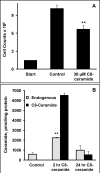Anti-proliferative effects of tricyclodecan-9-yl-xanthogenate (D609) involve ceramide and cell cycle inhibition
- PMID: 22415444
- PMCID: PMC3381991
- DOI: 10.1007/s12035-012-8254-0
Anti-proliferative effects of tricyclodecan-9-yl-xanthogenate (D609) involve ceramide and cell cycle inhibition
Erratum in
- Mol Neurobiol. 2012 Jun;45(3):465
Abstract
Tricyclodecan-9-yl-xanthogenate (D609) inhibits phosphatidylcholine (PC)-phospholipase C (PLC) and/or sphingomyelin (SM) synthase (SMS). Inhibiting SMS can increase ceramide levels, which can inhibit cell proliferation. Here, we examined how individual inflammatory and glia cell proliferation is altered by D609. Treatment with 100-μM D609 significantly attenuated the proliferation of RAW 264.7 macrophages, N9 and BV-2 microglia, and DITNC(1) astrocytes, without affecting cell viability. D609 significantly inhibited BrdU incorporation in BV-2 microglia and caused accumulation of cells in G(1) phase with decreased number of cells in the S phase. D609 treatment for 2 h significantly increased ceramide levels in BV-2 microglia, which, following a media change, returned to control levels 22 h later. This suggests that the effect of D609 may be mediated, at least in part, through ceramide increase via SMS inhibition. Western blots demonstrated that 2-h treatment of BV-2 microglia with D609 increased expression of the cyclin-dependent kinase (Cdk) inhibitor p21 and down-regulated phospho-retinoblastoma (Rb), both of which returned to basal levels 22 h after removal of D609. Exogenous C8-ceramide also inhibited BV-2 microglia proliferation without loss of viability and decreased BrdU incorporation, supporting the involvement of ceramide in D609-mediated cell cycle arrest. Our current data suggest that D609 may offer benefit after stroke (Adibhatla and Hatcher, Mol Neurobiol 41:206-217, 2010) through ceramide-mediated cell cycle arrest, thus restricting glial cell proliferation.
Figures







References
-
- Sultana R, Newman SF, Abdul HM, et al. Protective effect of D609 against amyloid-β 1-42 induced oxidative modification of neuronal proteins: Redox proteomics study. J Neurosci Res. 2006;84:409–417. - PubMed
-
- Zhou DH, Lauderback CM, Yu T, et al. D609 inhibits ionizing radiation-induced oxidative damage by acting as a potent antioxidant. J Pharmacol Exp Ther. 2001;298:103–109. - PubMed
-
- Amtmann E. The antiviral, antitumoural xanthate D609 is a competitive inhibitor of phosphatidylcholine-specific phospholipase C. Drugs Exp Clin Res. 1996;22:287–294. - PubMed
Publication types
MeSH terms
Substances
Grants and funding
LinkOut - more resources
Full Text Sources

